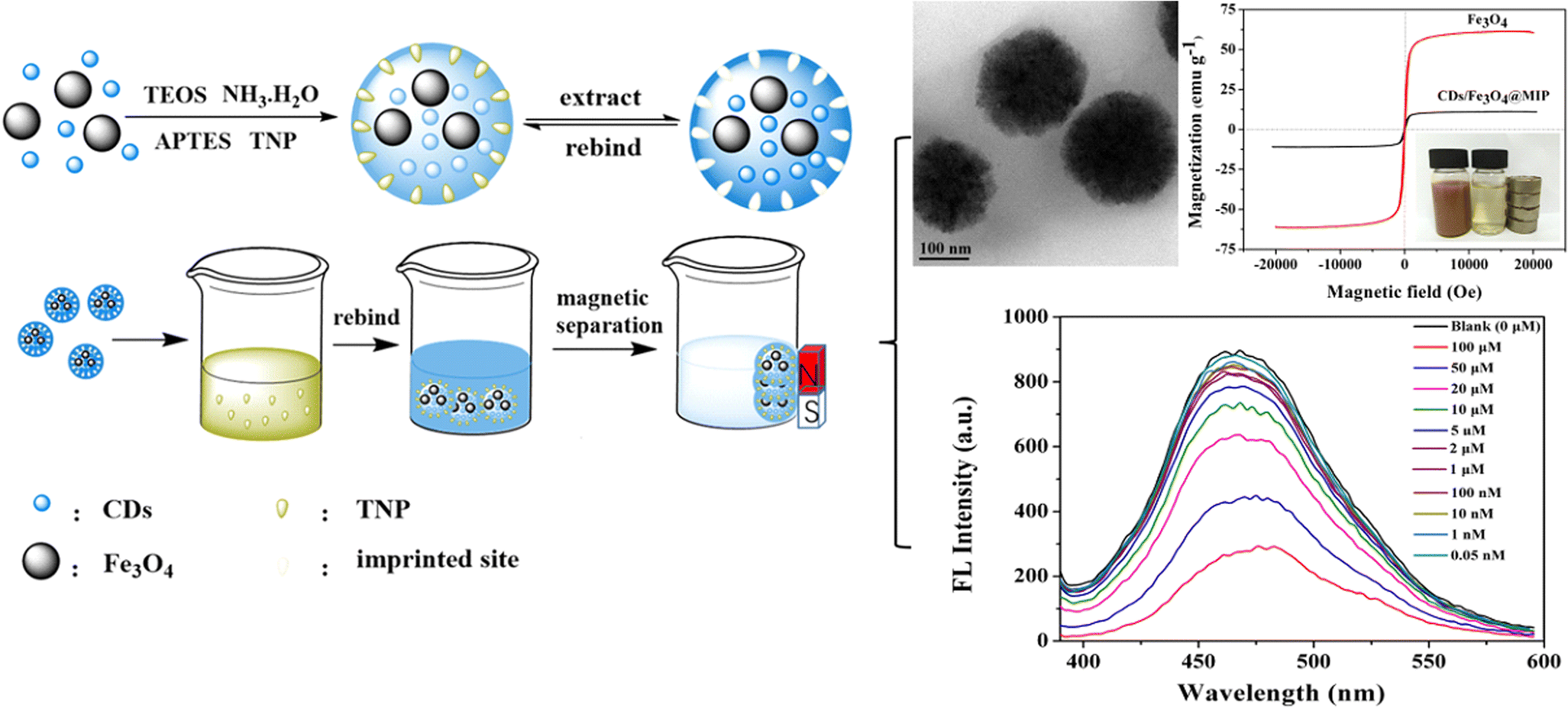当前位置:
X-MOL 学术
›
Microchim. Acta
›
论文详情
Our official English website, www.x-mol.net, welcomes your
feedback! (Note: you will need to create a separate account there.)
A magnetic and carbon dot based molecularly imprinted composite for fluorometric detection of 2,4,6-trinitrophenol
Microchimica Acta ( IF 5.3 ) Pub Date : 2019-01-10 , DOI: 10.1007/s00604-018-3200-0 Min Wang , Qifeng Fu , Kailian Zhang , Yuyan Wan , Lujun Wang , Manjie Gao , Zhining Xia , Die Gao
Microchimica Acta ( IF 5.3 ) Pub Date : 2019-01-10 , DOI: 10.1007/s00604-018-3200-0 Min Wang , Qifeng Fu , Kailian Zhang , Yuyan Wan , Lujun Wang , Manjie Gao , Zhining Xia , Die Gao

|
AbstractA magnetic molecularly imprinted composite was prepared by reverse microemulsion using carbon dots (CDs), Fe3O4 as the co-nucleus, and a molecularly imprinted polymer (MIP; with 2,4,6-trinitrophenol as the template) acting as recognition sites. The composite of type CD/Fe3O4@MIPs was characterized by transmission electron microscopy (TEM), energy dispersive spectroscopy (EDS), Fourier transform infrared spectroscopy (FT-IR), zeta potentiometric analysis, X-ray diffraction (XRD) and vibrating sample magnetometry (VSM). The results showed that the composite MIP has a spherical shape with average diameter of 200 nm. They also showed that the composite contains core-shell structures with several Fe3O4 nanoparticles and CDs embedded in each of the microsphere. The composite can extract 2,4,6-trinitrophenol (TNP) and has an imprinting factor of 3.6. It has high selectivity and sensitivity for TNP which acts as a quencher of the fluorescence of the CDs (with excitation/emission maxima at 370/470 nm). The limit of detection of this fluorometric TNP assay is 0.5 nM. The method was successfully applied to the determination of TNP in spiked tap water and river water samples, and recoveries ranged from 89.4% to 108.5% (with an RSD of <6%). Graphical abstractSchematic representation of the magnetic molecularly imprinted composite containing fluorescent carbon dots, Fe3O4 and molecularly imprinted polymer (CD/Fe3O4@MIPs). The CD/Fe3O4@MIPs were applied to the selective and sensitive detection of 2,4,6-trinitrophenol (TNP) by fluorometry.
中文翻译:

基于磁性和碳点的分子印迹复合材料用于 2,4,6-三硝基苯酚的荧光检测
摘要 以碳点(CDs)、Fe3O4为共核、分子印迹聚合物(MIP;以2,4,6-三硝基苯酚为模板)为识别位点,通过反相微乳液制备了磁性分子印迹复合材料。CD/Fe3O4@MIPs型复合材料通过透射电子显微镜(TEM)、能量色散光谱(EDS)、傅里叶变换红外光谱(FT-IR)、zeta电位分析、X射线衍射(XRD)和振动样品表征磁力计 (VSM)。结果表明,复合 MIP 呈球形,平均直径为 200 nm。他们还表明,该复合材料包含核壳结构,每个微球中嵌入了几个 Fe3O4 纳米颗粒和 CD。复合可以提取2,4,6-三硝基苯酚 (TNP),印记因子为 3.6。它对 TNP 具有高选择性和灵敏度,TNP 作为 CD 荧光的猝灭剂(激发/发射最大值在 370/470 nm)。这种荧光 TNP 检测的检测限为 0.5 nM。该方法成功应用于加标自来水和河水样品中 TNP 的测定,回收率范围为 89.4% 至 108.5%(RSD <6%)。图形摘要包含荧光碳点、Fe3O4 和分子印迹聚合物 (CD/Fe3O4@MIPs) 的磁性分子印迹复合材料的示意图。CD/Fe3O4@MIPs 应用于荧光法选择性和灵敏地检测 2,4,6-三硝基苯酚 (TNP)。它对 TNP 具有高选择性和灵敏度,TNP 作为 CD 荧光的猝灭剂(激发/发射最大值在 370/470 nm)。这种荧光 TNP 检测的检测限为 0.5 nM。该方法成功应用于加标自来水和河水样品中 TNP 的测定,回收率范围为 89.4% 至 108.5%(RSD <6%)。图形摘要包含荧光碳点、Fe3O4 和分子印迹聚合物 (CD/Fe3O4@MIPs) 的磁性分子印迹复合材料的示意图。CD/Fe3O4@MIPs 应用于荧光法选择性和灵敏地检测 2,4,6-三硝基苯酚 (TNP)。它对 TNP 具有高选择性和灵敏度,TNP 作为 CD 荧光的猝灭剂(激发/发射最大值在 370/470 nm)。这种荧光 TNP 检测的检测限为 0.5 nM。该方法成功应用于加标自来水和河水样品中 TNP 的测定,回收率范围为 89.4% 至 108.5%(RSD <6%)。图形摘要包含荧光碳点、Fe3O4 和分子印迹聚合物 (CD/Fe3O4@MIPs) 的磁性分子印迹复合材料的示意图。CD/Fe3O4@MIPs 应用于荧光法选择性和灵敏地检测 2,4,6-三硝基苯酚 (TNP)。该方法成功应用于加标自来水和河水样品中 TNP 的测定,回收率范围为 89.4% 至 108.5%(RSD <6%)。图形摘要包含荧光碳点、Fe3O4 和分子印迹聚合物 (CD/Fe3O4@MIPs) 的磁性分子印迹复合材料的示意图。CD/Fe3O4@MIPs 应用于荧光法选择性和灵敏地检测 2,4,6-三硝基苯酚 (TNP)。该方法成功应用于加标自来水和河水样品中 TNP 的测定,回收率范围为 89.4% 至 108.5%(RSD <6%)。图形摘要包含荧光碳点、Fe3O4 和分子印迹聚合物 (CD/Fe3O4@MIPs) 的磁性分子印迹复合材料的示意图。CD/Fe3O4@MIPs 应用于荧光法选择性和灵敏地检测 2,4,6-三硝基苯酚 (TNP)。
更新日期:2019-01-10
中文翻译:

基于磁性和碳点的分子印迹复合材料用于 2,4,6-三硝基苯酚的荧光检测
摘要 以碳点(CDs)、Fe3O4为共核、分子印迹聚合物(MIP;以2,4,6-三硝基苯酚为模板)为识别位点,通过反相微乳液制备了磁性分子印迹复合材料。CD/Fe3O4@MIPs型复合材料通过透射电子显微镜(TEM)、能量色散光谱(EDS)、傅里叶变换红外光谱(FT-IR)、zeta电位分析、X射线衍射(XRD)和振动样品表征磁力计 (VSM)。结果表明,复合 MIP 呈球形,平均直径为 200 nm。他们还表明,该复合材料包含核壳结构,每个微球中嵌入了几个 Fe3O4 纳米颗粒和 CD。复合可以提取2,4,6-三硝基苯酚 (TNP),印记因子为 3.6。它对 TNP 具有高选择性和灵敏度,TNP 作为 CD 荧光的猝灭剂(激发/发射最大值在 370/470 nm)。这种荧光 TNP 检测的检测限为 0.5 nM。该方法成功应用于加标自来水和河水样品中 TNP 的测定,回收率范围为 89.4% 至 108.5%(RSD <6%)。图形摘要包含荧光碳点、Fe3O4 和分子印迹聚合物 (CD/Fe3O4@MIPs) 的磁性分子印迹复合材料的示意图。CD/Fe3O4@MIPs 应用于荧光法选择性和灵敏地检测 2,4,6-三硝基苯酚 (TNP)。它对 TNP 具有高选择性和灵敏度,TNP 作为 CD 荧光的猝灭剂(激发/发射最大值在 370/470 nm)。这种荧光 TNP 检测的检测限为 0.5 nM。该方法成功应用于加标自来水和河水样品中 TNP 的测定,回收率范围为 89.4% 至 108.5%(RSD <6%)。图形摘要包含荧光碳点、Fe3O4 和分子印迹聚合物 (CD/Fe3O4@MIPs) 的磁性分子印迹复合材料的示意图。CD/Fe3O4@MIPs 应用于荧光法选择性和灵敏地检测 2,4,6-三硝基苯酚 (TNP)。它对 TNP 具有高选择性和灵敏度,TNP 作为 CD 荧光的猝灭剂(激发/发射最大值在 370/470 nm)。这种荧光 TNP 检测的检测限为 0.5 nM。该方法成功应用于加标自来水和河水样品中 TNP 的测定,回收率范围为 89.4% 至 108.5%(RSD <6%)。图形摘要包含荧光碳点、Fe3O4 和分子印迹聚合物 (CD/Fe3O4@MIPs) 的磁性分子印迹复合材料的示意图。CD/Fe3O4@MIPs 应用于荧光法选择性和灵敏地检测 2,4,6-三硝基苯酚 (TNP)。该方法成功应用于加标自来水和河水样品中 TNP 的测定,回收率范围为 89.4% 至 108.5%(RSD <6%)。图形摘要包含荧光碳点、Fe3O4 和分子印迹聚合物 (CD/Fe3O4@MIPs) 的磁性分子印迹复合材料的示意图。CD/Fe3O4@MIPs 应用于荧光法选择性和灵敏地检测 2,4,6-三硝基苯酚 (TNP)。该方法成功应用于加标自来水和河水样品中 TNP 的测定,回收率范围为 89.4% 至 108.5%(RSD <6%)。图形摘要包含荧光碳点、Fe3O4 和分子印迹聚合物 (CD/Fe3O4@MIPs) 的磁性分子印迹复合材料的示意图。CD/Fe3O4@MIPs 应用于荧光法选择性和灵敏地检测 2,4,6-三硝基苯酚 (TNP)。













































 京公网安备 11010802027423号
京公网安备 11010802027423号